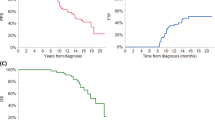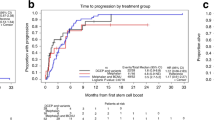Abstract
The importance of achieving a very good partial response or better (⩾VGPR) after induction treatment of myeloma has traditionally only been discussed in the context of high-dose therapy with auto-SCT (HDT/auto-SCT). Of late, the advent of novel agents for induction treatment has resulted in improved CR and VGPR rates, which are comparable with those observed with HDT/auto-SCT. We show that in an unselected group of 179 myeloma patients with diverse baseline characteristics, and treated with different modern induction regimens within a single institution, the attainment of ⩾VGPR with or without HDT/auto-ASCT represents a major surrogate marker of better clinical outcomes. On the basis of a 1-year landmark survival analysis, patients achieving ⩾VGPR enjoy a significantly longer PFS, which translated to a longer OS. Superseding the adverse effects of advanced age, high International Staging System (ISS) stage, adverse cytogenetics and independent of the transplant status, the attainment of ⩾VGPR emerged as the single most significant predictor of long-term survival on multivariate analysis.
This is a preview of subscription content, access via your institution
Access options
Subscribe to this journal
Receive 12 print issues and online access
$259.00 per year
only $21.58 per issue
Buy this article
- Purchase on Springer Link
- Instant access to full article PDF
Prices may be subject to local taxes which are calculated during checkout


Similar content being viewed by others
References
Attal M, Harousseau JL, Facon T, Guilhot F, Doyen C, Fuzibet JG et al. Single versus double autologous stem-cell transplantation for multiple myeloma. N Engl J Med 2003; 349: 2495–2502.
Barlogie B, Tricot G, Anaissie E, Shaughnessy J, Rasmussen E, van Rhee F et al. Thalidomide and hematopoietic-cell transplantation for multiple myeloma. N Engl J Med 2006; 354: 1021–1030.
Cavo M, Di Raimondo F, Zamagni E, Patriarca F, Tacchetti P, Casulli AF et al. Short-term thalidomide incorporated into double autologous stem-cell transplantation improves outcomes in comparison with double autotransplantation for multiple myeloma. J Clin Oncol 2009; 27: 5001–5007.
Child JA, Morgan GJ, Davies FE, Owen RG, Bell SE, Hawkins K et al. High-dose chemotherapy with hematopoietic stem-cell rescue for multiple myeloma. N Engl J Med 2003; 348: 1875–1883.
Lahuerta JJ, Martinez-Lopez J, Serna JD, Bladé J, Grande C, Alegre A et al. Remission status defined by immunofixation vs. electrophoresis after autologous transplantation has a major impact on the outcome of multiple myeloma patients. Br J Haematol 2000; 109: 438–446.
Van de Velde H, Liu X, Chen G, Cakana A, Deraedt W, Bayssas M . Complete response correlates with long-term survival and progression-free survival in high-dose therapy in multiple myeloma. Haematologica 2007; 92: 1399–1406.
Wang M, Delasalle K, Feng L, Thomas S, Giralt S, Qazilbash M et al. CR represents an early index of potential long survival in multiple myeloma. 2009; (e-pub ahead of print 27 July 2009) PMID: 19633690.
Harousseau J-L, Attal M, Moreau P, Garban F, Facon T, Avet-Loiseau H . The prognostic impact of complete remission (CR) plus very good partial remission (VGPR) in a double transplantation program for newly diagnosed multiple myeloma (MM): combined results of the IFM 99 trials. Blood 2006; 108 (Abstract 3077).
Haessler J, Shaughnessy JD, Zhan F, Crowley J, Epstein J, van Rhee F et al. Benefit of complete response in multiple myeloma limited to high-risk subgroup identified by gene expression profiling. Clin Cancer Res 2007; 13: 7037–7079.
Barlogie B, Anaissie E, Haessler J, van Rhee F, Pineda-Roman M, Hollmig K et al. Complete remission sustained 3 years from treatment initiation is a powerful surrogate for extended survival in multiple myeloma. Cancer 2008; 113: 355–359.
Richardson PG, Mitsiadis C, Schlossman R, Munshi N, Anderson K . New drugs for myeloma. Oncologist 2007; 12: 664–689.
Jagannath S . Current standards for first-line therapy of multiple myeloma. Clin Lymphoma Myeloma 2007; 5: 207–214.
Kyle RA, Rajkumar SV . Multiple myeloma. Blood 2008; 111: 2962–2972.
Harousseau JL, Mathiot C, Attal M, Marit G, Caillot D, Hullin C et al. Bortezomib/dexamethasone versus VAD as induction prior to autologous stem cell transplantation (ASCT) in previously untreated multiple myeloma (MM): updated data from IFM 2005/01 trial. J Clin Oncol 2008; 26 (Abstract 8505).
Zonder JA, Crowley JJ, Bolejack V, Hussein M, Morre DF, Whittenberger BF et al. A randomized Southwest Oncology Group study comparing dexamethasone (D) to lenalidomide + dexamethasone (LD) as treatment of newly-diagnosed multiple myeloma (NDMM): impact of cytogenetic abnormalities on efficacy of LD, and updated overall study results. J Clin Oncol 2008; 26 (Abstract 8521).
Harousseau JL, Avet-Loiseau H, Attal M, Charbonnel C, Garban F, Hulin C et al. Achievement of at least very good partial response is a simple and robust prognostic factor in patients with multiple myeloma treated with high-dose therapy: long-term analysis of the IFM 99-02 and 99-04 trials. J Clin Oncol 2009; 27: 5720–5726.
Rajkumar SV, Blood E, Vesole D, Fonseca R, Greipp PR . Phase III clinical trial of thalidomide plus dexamethasone compared with dexamethasone alone in newly diagnosed multiple myeloma: a clinical trial coordinated by the Eastern Cooperative Oncology Group. J Clin Oncol 2006; 24: 431–436.
Palumbo A, Bringhen S, Caravita T, Merla E, Capparella V, Callea V et al. Oral melphalan and prednisone chemotherapy plus thalidomide compared with melphalan and prednisone alone in elderly patients with multiple myeloma: randomised controlled trial. Lancet 2006; 367: 825–831.
Mateos MV, Hernandez JM, Hernandez MT, Gutierrez NC, Palomera L, Fuertes M et al. Bortezomib plus melphalan and prednisone in elderly untreated patients with multiple myeloma: results of a multicenter phase 1/2 study. Blood 2006; 108: 2165–2172.
San Miguel JF, Schlag R, Khuageva NK, Dimopoulos MA, Shpilberg O, Kropff M et al. Bortezomib plus melphalan and prednisone for initial treatment of multiple myeloma. N Engl J Med 2008; 359: 906–917.
Moreau P, Facon T, Attal M, Hulin C, Michallet M, Maloisel F et al. Comparison of 200 mg/m(2) melphalan and 8 Gy total body irradiation plus 140 mg/m(2) melphalan as conditioning regimens for peripheral blood stem cell transplantation in patients with newly diagnosed multiple myeloma: final analysis of the Intergroupe Francophone du Myelome 9502 randomized trial. Blood 2002; 99: 731–735.
Durie BG, Harousseau JL, San Miguel JS, Bladé J, Barlogie B, Anderson K et al. International uniform response criteria for multiple myeloma. Leukemia 2006; 20: 1467–1473.
Kaplan EL, Meier P . Nonparametric estimation from incomplete observations. Am Stat assoc 1958; 53: 457–484.
Peto R, Pike MC . Conservatism of the approximation sigma (O-E)2-E in the log rank test for survival data or tumor incidence data. Biometrics 1973; 29: 579–584.
Anderson J, Cain K, Gelber R . Analysis of survival by tumor response. J Clin Oncol 1983; 1: 710–719.
Cox DR . Regression models and life-tables. J Royal Stat Soc B 1972; 34: 187–220.
Lahuerta J, Mateos M, Martínez-Lo′pez J, Rosiñol L, Sureda A, de la Rubia J et al. Influence of pre- and post-transplantation responses on outcome of patients with multiple myeloma: sequential improvement of response and achievement of complete response are associated with longer survival. J Clin Oncol 2008; 26: 5775–5782.
Hoering A, Crowley J, Shaughnessy Jr JD, Hollmig K, Alsayed Y, Szymonifka J et al. Complete remission in multiple myeloma examined as time-dependent variable in terms of both onset and duration in total therapy protocols. Blood 2009; 114: 1299–1305.
Dingli D, Pacheco JM, Nowakowski GS, Kumar SK, Dispenzieri A, Hayman SR et al. Relationship between depth of response and outcome in multiple myeloma. J Clin Oncol 2007; 25: 4933–4937.
Kumar S, Dingli D, Dispenzieri A, Lacy M, Hayman SR, Buadi F et al. Impact of additional cytoreduction following autologous SCT in multiple myeloma. 2008; 42: 259–264.
Ladetto M, Pagliano G, Avonto I, Santo L, Ferrero S, Cavallo F et al. Consolidation with bortezomib, thalidomide and dexamethasone induces molecular remissions in autografted multiple myeloma patients. Blood 2007; 110 (Abstract 163).
Arzoumanian V, Hoering A, Sawyer J, van Rhee F, Bailey C, Gurley J et al. Suppression of abnormal karyotypes is critical for prolonged survival in myeloma. Leukemia 2008; 22: 850–855.
Harousseau JL, Mathiot C, Attal M, Marit G, Caillot D, Mohty MM et al. Velcade/dexamethasone versus VAD as induction treatment prior to autologous stem cell transplantation in newly diagnosed patients: updated results of the IFM 2005/01 trial [abstract]. Blood 2007; 110 (Abstract 139).
Pineda-Roman M, Bolejack V, Arzoumian V, Anaissie E, van Rhee F, Zangari M et al. Complete response in myeloma extends survival, but not with history of prior monoclonal gammopathy of undetermined significance or smouldering disease. Br J Haematol 2007; 136: 393–399.
van Rhee F, Bolejack V, Hollmig K, Pineda-Roman M, Anaissie E, Epstein J et al. High serum-free light chain levels and their rapid reduction in response define an aggressive multiple myeloma subtype with poor prognosis. Blood 2007; 110: 827–832.
Rajkumar SV, Jacobus S, Callander N, Fonseca R, Vesole D, Williams MV et al. Randomized trial of lenalidomide plus high-dose dexamethasone versus lenalidomide plus low-dose dexamethasone in newly diagnosed myeloma (E4A03), a trial coordinated by the Eastern Cooperative Oncology Group: analysis of response, survival, and outcome with primary therapy and stem cell transplantation. J Clin Oncol 2008; 26 (Abstract 8504).
Alexanian R, Weber D, Giralt S, Dimopoulos M, Delasalle K, Smith T et al. Impact of complete remission with intensive therapy in patients with responsive multiple myeloma. Bone Marrow Transplant 2001; 27: 1037–1043.
Author information
Authors and Affiliations
Corresponding author
Additional information
Presented in part at the 14th Congress of European Haematology Association, Berlin, Germany, June 2009 (Abstract 0960).
Rights and permissions
About this article
Cite this article
Tan, D., Lao, Z., Loh, Y. et al. Attainment of at least a very good partial response after induction treatment is an important surrogate of longer survival for multiple myeloma. Bone Marrow Transplant 45, 1625–1630 (2010). https://doi.org/10.1038/bmt.2010.25
Received:
Revised:
Accepted:
Published:
Issue Date:
DOI: https://doi.org/10.1038/bmt.2010.25
Keywords
This article is cited by
-
Efficacy of a referral center for patient-centered care in multiple myeloma: a cohort study
BMC Health Services Research (2015)



